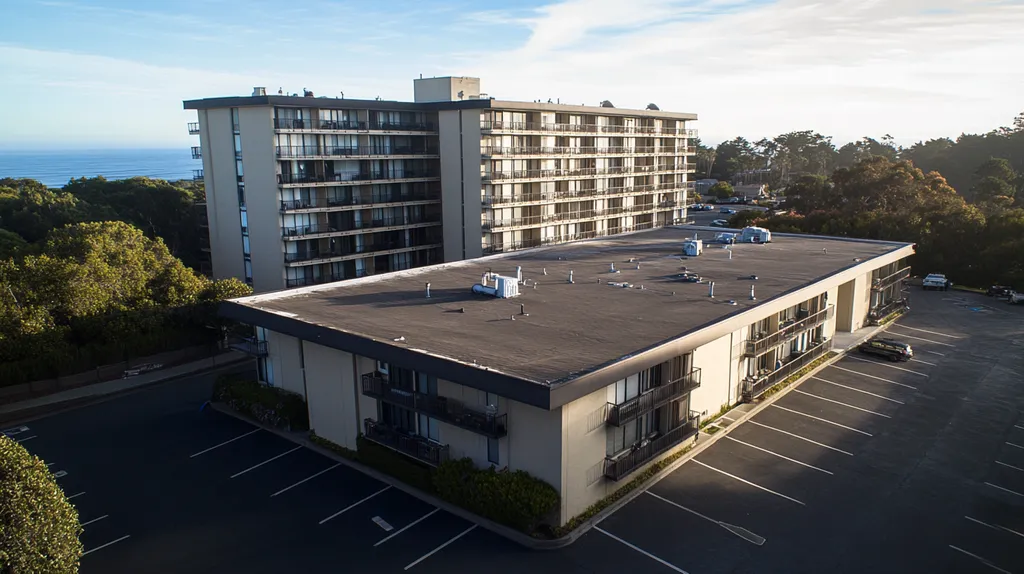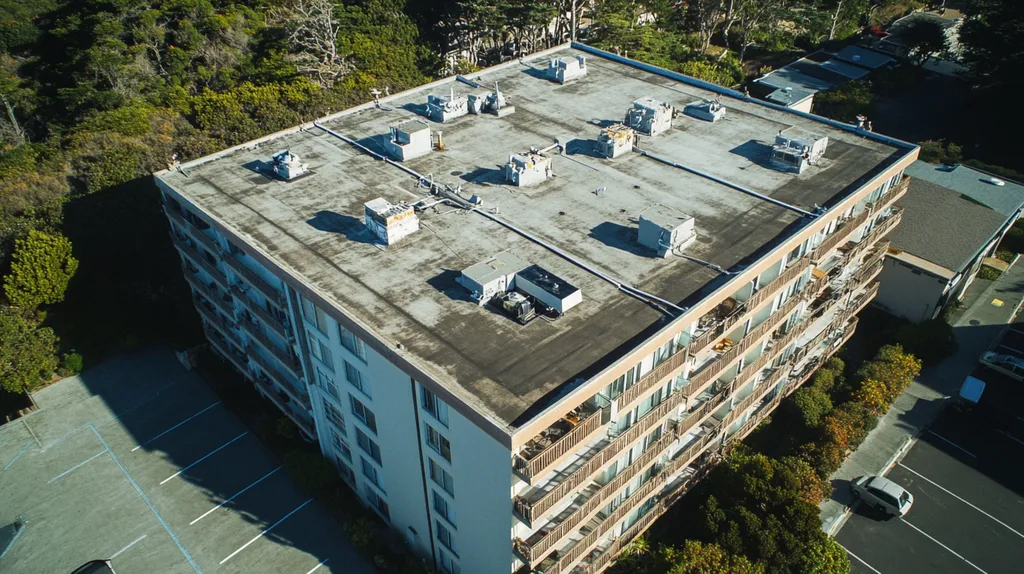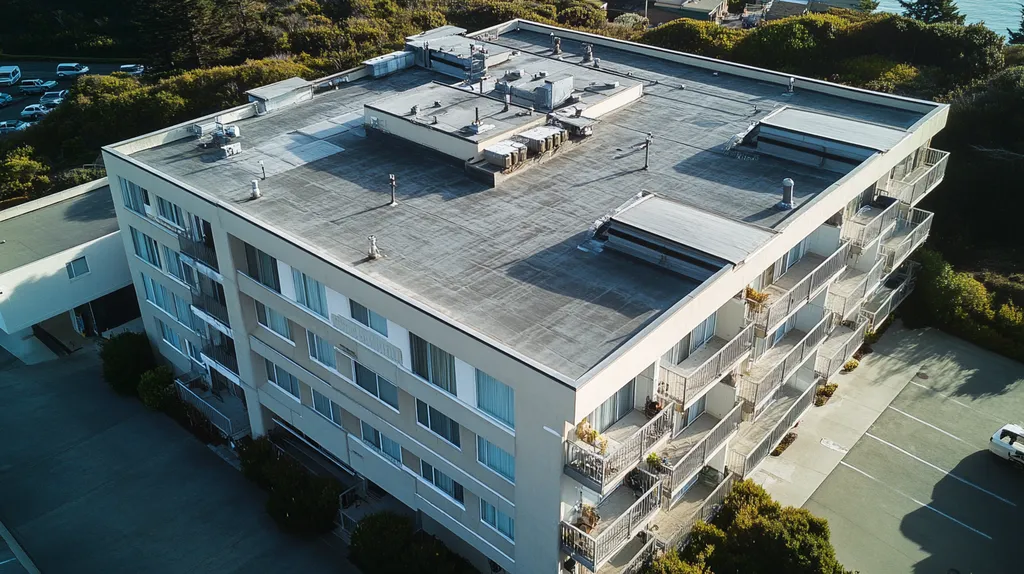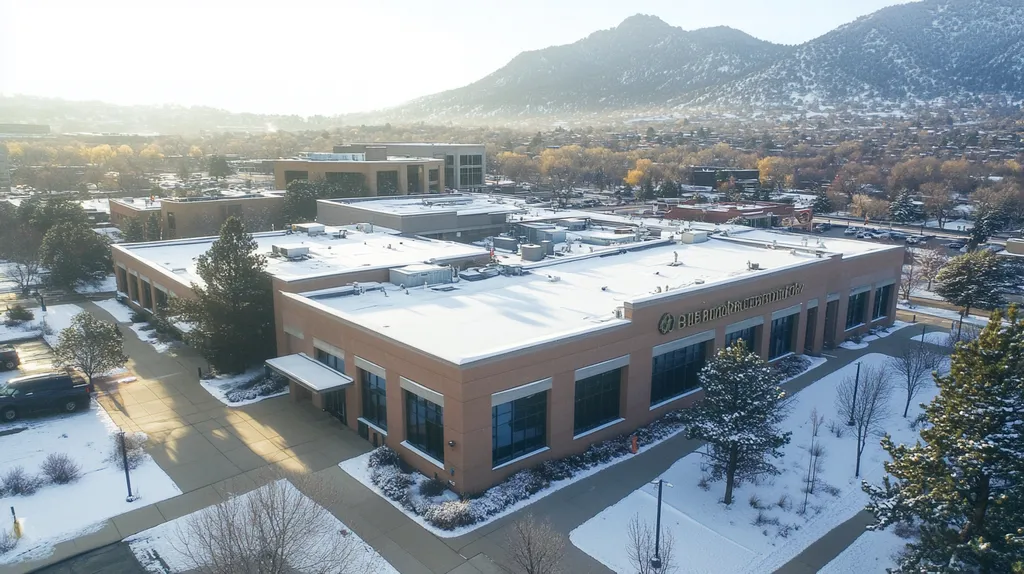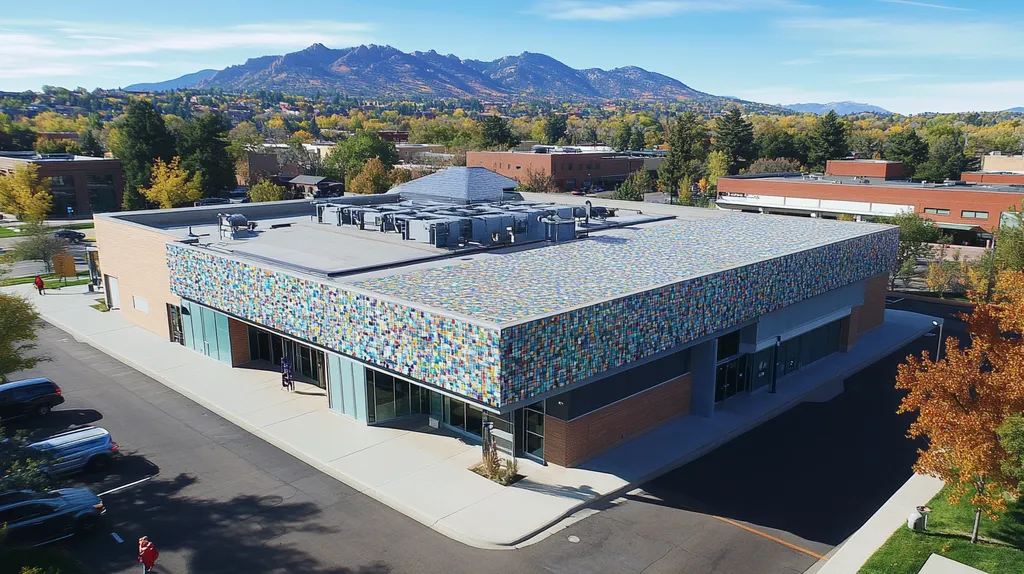As energy costs soar and environmental regulations tighten, commercial building owners face mounting pressure to adopt sustainable roofing solutions. Studies show that buildings account for nearly 40% of U.S. energy consumption, with roofing systems directly impacting up to 30% of a facility’s energy use.
The choice between traditional and eco-friendly roofing materials now carries significant financial and environmental consequences. From cool roofs that reflect solar radiation to living green systems that manage stormwater, sustainable options offer compelling alternatives to conventional materials.
This guide examines the key factors driving the shift toward eco-friendly commercial roofing, exploring practical solutions that balance environmental responsibility with bottom-line performance.
SECTION 1: THE BASICS EXPLAINED
Commercial buildings account for nearly 40% of U.S. energy consumption, with roofing systems playing a crucial role in this energy equation. As climate concerns intensify and energy costs rise, facility managers face mounting pressure to adopt sustainable roofing solutions. The decision between traditional and eco-friendly roofing impacts not just individual buildings, but entire communities and urban environments.
What It Is (In Plain Language)
Eco-friendly roofing encompasses materials and systems that minimize environmental impact while maximizing building performance. These solutions include white or cool roofs made of TPO or PVC, which reflect solar radiation and reduce cooling costs. (source: MSRS)
Green roofs incorporate living vegetation, providing natural insulation and managing stormwater runoff. These systems transform unused roof space into functional environmental assets.
Metal roofing represents another sustainable choice, offering durability and recyclability. These systems can last up to 50 years and often contain significant recycled content.
Smart material selection considers the full lifecycle impact, from manufacturing through eventual disposal. This comprehensive approach ensures truly sustainable outcomes.
Why It Matters (To Your Building)
Energy efficiency stands as the primary benefit of eco-friendly roofing. Proper material selection can reduce cooling costs by up to 30% in summer months, directly impacting operating budgets.
Building codes and environmental regulations increasingly mandate sustainable building practices. Forward-thinking roof choices help ensure compliance while avoiding costly retrofits later.
Property values benefit from sustainable features, with eco-friendly buildings commanding premium rates. These improvements often pay for themselves through reduced operating costs and higher occupancy rates.
Local climate conditions influence the effectiveness of different roofing solutions. What works in Miami may not work in Minneapolis, making careful system selection crucial.
How It Works
Cool roofing systems reflect sunlight and heat through specialized materials or coatings. This reflection reduces heat absorption and transfers less heat into the building below.
Vegetative roofs create a natural barrier between the sun and building structure. Plants and growing medium absorb rainfall, provide shade, and cool through evaporation.
Thermal barriers and advanced insulation work together with reflective surfaces to maintain desired interior temperatures. This combination optimizes energy performance year-round.
Modern eco-friendly systems often integrate multiple technologies. Solar panels can complement cool roofs, while drainage systems work with green roofs to manage stormwater.
SECTION 2: PRACTICAL APPLICATIONS
Commercial building owners face mounting pressure to adopt sustainable roofing solutions as energy costs soar and environmental regulations tighten. With roofing systems directly impacting up to 30% of a building’s energy consumption, choosing the right eco-friendly option becomes critical for long-term operational success. Understanding practical applications helps facility managers maximize their return on investment while meeting increasingly strict sustainability requirements.
Common Uses & Examples
Cool roofing systems have emerged as a leading solution for large commercial facilities, particularly in warm climates. These materials reflect more sunlight and absorb less heat than standard roofing, reducing heat gain and decreasing air conditioning costs by up to 15%. (source: U.S. Environmental Protection Agency)
Vegetative roofing systems excel in urban environments where stormwater management is crucial. These installations transform unused roof space into functional environmental assets while providing natural insulation.
Manufacturing facilities often opt for metal roofing systems due to their durability and recyclability. These roofs can integrate seamlessly with solar panels, maximizing renewable energy potential.
Retail properties frequently choose white TPO or PVC membranes to reduce cooling loads while maintaining aesthetic appeal. These materials offer excellent durability and can lower rooftop temperatures by up to 50°F compared to dark surfaces.
When You Need It Most
The optimal time to transition to eco-friendly roofing comes during planned renovations or when existing roofs approach the end of their service life. This timing minimizes disruption and maximizes the return on investment.
Buildings with high cooling loads or those in urban heat islands benefit most immediately from reflective roofing solutions. The energy savings can offset installation costs within 3-5 years.
Properties pursuing green building certifications should prioritize sustainable roofing early in the process. These systems can contribute significant points toward LEED and other environmental certifications.
Facilities experiencing frequent maintenance issues or rising energy costs should consider immediate upgrades. Proactive replacement often proves more cost-effective than continuing repairs on inefficient systems.
Interactions With Other Systems
Eco-friendly roofing works in concert with building automation systems to optimize energy performance. Smart sensors can adjust HVAC operations based on roof surface temperatures and ambient conditions.
Stormwater management systems benefit from green roof installations, reducing the load on municipal infrastructure. These systems can handle up to 80% of rainfall events without overwhelming drainage networks.
Lighting systems require recalibration when reflective roofing is installed. The increased ambient light can reduce artificial lighting needs in top-floor spaces.
Building envelope components must be evaluated holistically when implementing sustainable roofing. Proper air barriers and insulation ensure maximum benefit from eco-friendly installations.
SECTION 3: KEY TERMINOLOGY DECODED
The complexity of eco-friendly roofing terminology creates significant barriers for commercial property owners making critical infrastructure decisions. Studies show that misunderstanding technical terms leads to costly installation errors and missed sustainability opportunities. Clear comprehension of industry language directly impacts project success, regulatory compliance, and long-term cost savings.
Essential Terms Explained
Solar reflectance measures a roof’s ability to reflect sunlight, with higher values indicating better heat rejection. This property significantly influences cooling costs and building comfort throughout the summer months.
Sustainable roof coatings like VOC-free options reduce solar heat absorption by 20-50%, substantially decreasing cooling requirements. These coatings provide enhanced adhesion while maintaining lower roof surface temperatures. (source: Castagra)
Thermal emittance describes how readily a surface releases absorbed heat. Materials with high emittance values cool more quickly, reducing heat transfer into the building structure.
The Solar Reflectance Index (SRI) combines reflectance and emittance measurements into a single value. Higher SRI numbers indicate better overall thermal performance, making comparison between different roofing systems more straightforward.
Industry Jargon Translated
Building envelope refers to the physical separation between conditioned and unconditioned environments. The roof represents a critical component of this system, directly impacting energy efficiency and indoor comfort.
Thermal bridging occurs when materials with poor insulating properties create pathways for heat transfer. Identifying and addressing these weak points ensures optimal roof system performance.
Cool roof assemblies incorporate materials specifically designed to minimize heat absorption. These systems typically combine reflective surfaces with appropriate insulation layers to maximize energy efficiency.
Living roof infrastructure includes waterproofing membranes, root barriers, and drainage layers. Understanding these components helps facility managers maintain vegetative roofing systems effectively.
Measurement & Units Simplified
R-value quantifies thermal resistance, with higher numbers indicating better insulation performance. Most commercial buildings require minimum R-values between R-20 and R-35, depending on climate zone and local building codes.
Solar reflectance is measured on a scale from 0 to 1, with 1 representing perfect reflection. Cool roofs typically achieve values of 0.65 or higher, significantly reducing cooling loads.
Load capacity ratings use pounds per square foot (PSF) to specify maximum weight limits. These measurements become particularly important when considering green roof installations or solar panel arrays.
Life-cycle cost analysis examines expenses over 15-30 year periods. This timeline allows accurate comparison between different roofing systems by including maintenance, energy savings, and replacement costs.
SECTION 4: DECISION FACTORS
Selecting eco-friendly roofing represents a critical decision point for commercial property owners, with implications spanning decades. Each year, inefficient roofing choices drain millions in unnecessary energy costs while contributing to environmental degradation. The stakes are particularly high as energy prices continue to climb and sustainability regulations tighten. Understanding the key decision factors helps facility managers navigate these complex choices while balancing immediate needs against long-term value.
Cost Considerations
Initial costs for eco-friendly roofing typically run 15-30% higher than traditional options, but this premium must be evaluated against substantial long-term savings. Many sustainable solutions pay for themselves within 3-5 years through reduced energy and maintenance costs.
Federal, state, and local incentives can significantly offset upfront expenses. Tax credits, rebates, and accelerated depreciation schedules make eco-friendly options increasingly competitive with conventional materials.
Sustainable roof coatings reduce solar heat absorption by 20-50%, substantially decreasing cooling costs while providing superior adhesion and durability. These coatings offer a cost-effective path to sustainability without requiring complete roof replacement. (source: Castagra)
Financing options have expanded dramatically, with many manufacturers offering specialized programs for sustainable roofing. These programs can help spread costs over time while delivering immediate energy savings.
Performance Trade-offs
Different eco-friendly solutions excel in specific environments but may underperform in others. Cool roofs provide maximum benefit in hot climates but might increase heating costs in colder regions.
Structural considerations become crucial when evaluating green roofs or solar installations. While these systems offer exceptional environmental benefits, they require careful assessment of load-bearing capacity.
Material durability varies significantly among sustainable options. Some newer eco-friendly materials may lack long-term performance data, making manufacturer warranties and testing certifications essential evaluation criteria.
Installation expertise plays a vital role in system performance. Specialized training and experience with sustainable materials often determine whether a system achieves its full potential.
Lifespan & Durability Factors
Quality eco-friendly roofing systems typically last 20-30 years, significantly outlasting many traditional options. This extended lifespan reduces waste and minimizes the environmental impact of replacement cycles.
Climate resilience becomes increasingly important as weather patterns intensify. Sustainable materials often demonstrate superior resistance to UV damage, temperature extremes, and severe weather events.
Maintenance requirements vary widely among eco-friendly options. Some systems require minimal upkeep, while others need regular attention to maintain peak performance and warranty compliance.
End-of-life considerations impact total cost of ownership. Many sustainable materials offer recycling potential, reducing disposal costs and environmental impact while potentially generating salvage value.
SECTION 5: COMMON CHALLENGES
While eco-friendly roofing promises significant environmental and financial benefits, implementation challenges can derail even the best-planned projects. Industry data shows that up to 30% of sustainable roofing installations underperform due to preventable issues. From material compatibility problems to installation errors, these challenges threaten both immediate performance and long-term sustainability goals.
Frequent Problems & Solutions
Inadequate substrate preparation remains a leading cause of premature roof failure. Proper surface cleaning, repair of existing damage, and moisture testing must precede any sustainable roofing installation.
Sustainable roof coatings applied over existing roofs can reduce solar energy absorption by 20-50%, but only when properly installed. Zero-VOC coatings like those made with renewable castor oil offer superior adhesion while maintaining environmental benefits. (source: Castagra)
Poor drainage design frequently undermines green roof performance. Installing adequate slope and maintaining clear drainage paths prevents water accumulation and extends system life.
Material incompatibility issues arise when combining different eco-friendly components. Careful product selection and manufacturer consultation ensures all materials work together effectively.
Warning Signs To Watch For
Visible seam separation or membrane lifting indicates potential adhesion failures. These issues require immediate attention to prevent system-wide deterioration.
Uneven plant growth or bare patches on green roofs signal underlying problems. Regular monitoring helps identify irrigation issues, soil deficiencies, or drainage blockages early.
Increased energy bills despite eco-friendly installations suggest performance degradation. Energy monitoring systems can pinpoint efficiency losses and guide corrective action.
Interior moisture stains or unusual odors often indicate membrane breaches. Swift investigation and repair prevents costly structural damage and mold growth.
Preventative Approaches
Implementing comprehensive maintenance schedules prevents minor issues from escalating. Quarterly inspections should include membrane examination, drainage testing, and vegetation health assessment.
Documentation of all maintenance activities creates valuable performance history. This data helps identify patterns and predict potential failures before they occur.
Staff training on proper roof access and maintenance procedures reduces accidental damage. Clear protocols for equipment installation and repair activities protect roof integrity.
Regular updating of emergency response plans ensures quick action during severe weather events. Having repair materials and qualified contractors on standby minimizes downtime and damage.
SECTION 6: NEXT STEPS & RESOURCES
The transition to eco-friendly commercial roofing requires careful navigation of options, standards, and implementation strategies. With buildings accounting for nearly 40% of U.S. energy consumption, choosing the right sustainable roofing solution becomes increasingly critical. Property owners and facility managers who understand how to evaluate providers, interpret standards, and leverage available resources position themselves to make informed decisions that benefit both their bottom line and environmental impact.
Questions To Ask Providers
Start by requesting detailed documentation of material composition and recycled content percentages. Recycled shingles and rubber roofing materials can last up to 50 years while significantly reducing environmental impact and installation costs. (source: Smart Cities Dive)
Demand specific performance metrics for energy efficiency and cost savings. Quality providers should offer documented case studies demonstrating actual results in similar building types and climate zones.
Verify installer certifications and specialized training for eco-friendly systems. Installation expertise directly impacts system performance and warranty coverage.
Request detailed maintenance protocols and support commitments. Clear documentation helps protect your investment and ensures optimal system performance throughout its lifecycle.
Industry Standards & Guidelines
Familiarize yourself with ENERGY STAR roof product requirements, which establish minimum solar reflectance values for low-slope and steep-slope applications. These standards provide benchmarks for comparing different solutions.
Review local building codes and environmental regulations affecting commercial roofing. Many jurisdictions now mandate minimum sustainability standards for new installations and major renovations.
Understand LEED certification requirements related to roofing systems. Points awarded for sustainable roofing can significantly impact overall building certification levels.
Consider Cool Roof Rating Council (CRRC) ratings when evaluating materials. These independent ratings help compare thermal performance across different products and manufacturers.
Further Learning Simplified
Connect with professional organizations like the National Roofing Contractors Association (NRCA) and Green Roofs for Healthy Cities. These groups offer extensive educational resources and technical guidance.
Explore manufacturer training programs and product documentation. Many leading manufacturers provide detailed technical information and installation guidelines online.
Subscribe to industry publications focusing on sustainable building practices. These sources help track emerging technologies and evolving best practices.
Document lessons learned from your own installations and share experiences with peer networks. This practical knowledge often proves invaluable for future projects.
The Bottom Line
With commercial buildings consuming 40% of U.S. energy and roofing directly impacting up to 30% of facility energy use, the shift toward eco-friendly roofing has become imperative rather than optional.
Sustainable roofing solutions now offer compelling financial returns through energy savings of 15-30%, while meeting increasingly strict environmental regulations and building codes.
From cool roofs that reflect solar radiation to living green systems that manage stormwater, today’s eco-friendly options deliver both immediate and long-term benefits.
The key to success lies in careful material selection, proper installation by qualified contractors, and consistent maintenance protocols that protect these valuable investments.
Property owners who embrace sustainable roofing solutions today position themselves to lead in an increasingly efficiency-focused market while delivering measurable environmental impact.
FREQUENTLY ASKED QUESTIONS
Q. What eco-friendly options exist for commercial roof systems?
A. Eco-friendly roofing options include cool roofs, green roofs, and metal systems. Cool roofs reflect solar heat, while green roofs use vegetation for insulation and stormwater management. Metal roofs are durable and often made from recycled materials.
Q. How does an eco-friendly industrial roof save money?
A. Eco-friendly roofs can reduce cooling costs by up to 30%. Additionally, they often qualify for tax credits and rebates, making them a cost-effective choice for long-term savings on energy and maintenance.
Q. What is the lifespan of a typical commercial roof?
A. Most eco-friendly roofing systems last between 20-30 years. Their durability exceeds that of standard roofs, reducing the need for frequent replacements and minimizing waste over time.
Q. How can an eco-friendly roof enhance property value?
A. Properties with sustainable roofing often command higher market rates due to their energy efficiency and lower operating costs. Eco-friendly features can attract environmentally conscious tenants and buyers, boosting overall property value.
Q. What challenges arise with installing eco-friendly roofs?
A. Common challenges include inadequate surface preparation and drainage design issues. Proper installation practices and material compatibility are crucial for ensuring long-term performance and effectiveness of eco-friendly roofing systems.
Q. How to evaluate eco-friendly roof providers?
A. When selecting a provider, ask about their certifications, materials used, and performance metrics. Detailed documentation and case studies can help ensure they meet your sustainable roofing needs effectively.
Q. What are common eco-friendly roofing materials?
A. Common materials for eco-friendly roofs include TPO, PVC, and metal. These options are chosen for their durability, reflective properties, and potential for recycled content, making them suitable for sustainable roofing applications.

